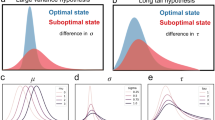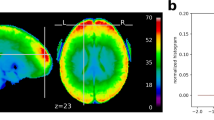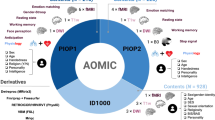Abstract
Response times (RTs) are often the main signal of interest in cognitive psychology but are often ignored in functional MRI (fMRI) analyses. In fMRI analysis the intensity of the signal serves as a proxy for the intensity of local neuronal activity, but changes in either the intensity or the duration of neuronal activity can yield identical fMRI signals. Therefore, if RTs are ignored and pair with neuronal durations, fMRI results claiming intensity differences may be confounded by RTs. We show how ignoring RTs goes beyond this confound, where longer RTs are paired with larger activation estimates, to lesser-known issues where RTs become confounds in group-level analyses and, surprisingly, how the RT confound can induce other artificial group-level associations with variables that are not related to the condition contrast or RTs. We propose a new time-series model to address these issues and encourage increasing focus on what the widespread RT-based signal represents.
This is a preview of subscription content, access via your institution
Access options
Access Nature and 54 other Nature Portfolio journals
Get Nature+, our best-value online-access subscription
$29.99 / 30 days
cancel any time
Subscribe to this journal
Receive 12 digital issues and online access to articles
$119.00 per year
only $9.92 per issue
Buy this article
- Purchase on Springer Link
- Instant access to full article PDF
Prices may be subject to local taxes which are calculated during checkout








Similar content being viewed by others

Data availability
The conjunction map (Fig. 7) and separate RT-based activation maps for each task used to generate the conjunction map are available in the form of 1 − P maps at https://neurovault.org/collections/13656/. The full, raw fMRI datasets are available on OpenNeuro at https://openneuro.org/datasets/ds004636/.
Code availability
The code for all analyses is shared at https://doi.org/10.5281/zenodo.8083510 (simulations) and https://doi.org/10.5281/zenodo.8083518 (real data analysis).
References
Donders, F. C. Over de snelheid van psychische processen [on the speed of psychological processes]. Acta Psychol. 30, 412–431 (1969).
Stroop, J. R. Studies of interference in serial verbal reactions. J. Exp. Psychol. 18, 643–662 (1935).
Botvinick, M. M. et al. Conflict monitoring and cognitive control. Psychol. Rev. 108, 624–652 (2001).
Botvinick, M. M. et al. Conflict monitoring versus selection-for-action in anterior cingulate cortex. Nature 402, 179–181 (1999).
MacDonald, A. W. et al. Dissociating the role of the dorsolateral prefrontal and anterior cingulate cortex in cognitive control. Science 288, 1835–1838 (2000).
Kerns, J. G. et al. Anterior cingulate conflict monitoring and adjustments in control. Science 303, 1023–1026 (2004).
Logothetis, N. K. What we can do and what we cannot do with fMRI. Nature 453, 869–878 (2008).
Savoy, R. et al. Pushing the temporal resolution of fMRI: studies of very brief visual stimuli, onset variability and asynchrony, and stimulus-correlated changes in noise. In Proc. of the ISMRM 3rd annual meeting, Nice, France, p. 450 (1995).
Jezzard, P., Matthews, P. & Smith, S. Functional MRI, an Introduction to Methods (Oxford Univ. Press, 2001).
Grinband, J., Wager, T. D., Lindquist, M., Ferrera, V. P. & Hirsch, J. Detection of time-varying signals in event-related fMRI designs. NeuroImage 43, 509–520 (2008).
Ratcliff, R. A theory of memory retrieval. Psychol. Rev. 85, 59–108 (1978).
Yarkoni, T. et al. BOLD correlates of trial-by-trial reaction time variability in gray and white matter: a multi-study fMRI analysis. PLoS ONE 4, e4257 (2009).
Grinband, J. et al. The dorsal medial frontal cortex is sensitive to time on task, not response conflict or error likelihood. NeuroImage 57, 303–311 (2011).
Carp, J. et al. Conditional differences in mean reaction time explain effects of response congruency, but not accuracy, on posterior medial frontal cortex activity. Front. Hum. Neurosci. https://doi.org/10.3389/fnhum.2010.00231 (2010).
Yeung, N., Cohen, J. D. & Botvinick, M. M. Errors of interpretation and modeling: a reply to Grinband et al. NeuroImage 57, 316–319 (2011).
Brown, J. W. Medial prefrontal cortex activity correlates with time-on-task: what does this tell us about theories of cognitive control? NeuroImage 57, 314–315 (2011).
Grinband, J. et al. Conflict, error likelihood, and RT: response to Brown & Yeung et al. NeuroImage 57, 320–322 (2011).
Nachev, P. The blind executive. NeuroImage 57, 312–313 (2011).
Carp, J., Fitzgerald, K. D., Taylor, S. F. & Weissman, D. H. Removing the effect of response time on brain activity reveals developmental differences in conflict processing in the posterior medial prefrontal cortex. NeuroImage 59, 853–860 (2012).
Poldrack, R. A., Mumford, J. A. & Nichols, T. E. Handbook of Functional MRI Data Analysis (Cambridge Univ. Press, 2009).
Ratcliff, R. & Murdock, B. B. Retrieval processes in recognition memory. Psychol. Rev. 83, 190–214 (1976).
Weissman, D. H. & Carp, J. The congruency effect in the posterior medial frontal cortex is more consistent with time on task than with response conflict. PLoS ONE 8, 62405 (2013).
Dubois, J. & Adolphs, R. Building a science of individual differences from fMRI. Trends Cogn. Sci. 20, 425–443 (2016).
Marek, S. et al. Reproducible brain-wide association studies require thousands of individuals. Nature 603, 654–660 (2022).
Mumford, J. A., Poline, J.-B. & Poldrack, R. A. Orthogonalization of regressors in fMRI models. PLoS ONE 10, 0126255 (2015).
Mumford, J. A. & Nichols, T. Modeling and inference of multisubject fMRI data. IEEE Eng. Med. Biol. Mag. 25, 42–51 (2006).
Fan, J. et al. Testing the efficiency and independence of attentional networks. J. Cogn. Neurosci. 14, 340–347 (2002).
MacDonald, A. et al. A convergent–divergent approach to context processing, general intellectual functioning, and the genetic liability to schizophrenia. Neuropsychology 19, 814–821 (2005).
Kirby, K. N. One-year temporal stability of delay-discount rates. Psychon. Bull. Rev. 16, 457–462 (2009).
Logan, G. & Bundesen, C. Clever homunculus: is there an endogenous act of control in the explicit task-cuing procedure? J. Exp. Psychol. Hum. Percept. Perform. 29, 575–599 (2003).
Logan, G. D. & Cowan, W. B. On the ability to inhibit simple and choice reaction time responses: a model and a method. J. Exp. Psychol. 10, 276–291 (1984).
DeJong, R., Coles, M. & Logan, G. Strategies and mechanisms in nonselective and selective inhibitory motor control. J. Exp. Psychol. Hum. Percept. Perform. 21, 498–511 (1995).
Sochat, V. et al. The experiment factory: standardizing behavioral experiments. Front. Psychol. 7, 610 (2016).
Bissett, P. G. et al. Cognitive tasks, anatomical MRI, and functional MRI data evaluating the construct of self regulation. Preprint at bioRxiv https://doi.org/10.1101/2023.09.27.559869 (2023).
Esteban, O. et al. fMRIPrep: a robust preprocessing pipeline for functional MRI. Nat. Methods 16, 111–116 (2019).
Greve, D. N. & Fischl, B. Accurate and robust brain image alignment using boundary-based registration. NeuroImage 48, 63–72 (2009).
Jenkinson, M., Bannister, P., Brady, M. & Smith, S. Improved optimization for the robust and accurate linear registration and motion correction of brain images. NeuroImage 17, 825–841 (2002).
Cox, R. W. & S, H. J. Software tools for analysis and visualization of fMRI data. NMR Biomed. 10, 171–178 (1997).
Pruim, R. H. R. et al. ICA-AROMA: a robust ICA-based strategy for removing motion artifacts from fMRI data. NeuroImage 112, 267–277 (2015).
Abraham, A. et al. Machine learning for neuroimaging with scikit-learn. Front. Neuroinform. 8, 14 (2014).
Smith, S. & Nichols, T. Threshold-free cluster enhancement: addressing problems of smoothing, threshold dependence and localisation in cluster inference. NeuroImage 44, 83–98 (2009).
Nichols, T. et al. Valid conjunction inference with the minimum statistic. NeuroImage 25, 653–660 (2005).
Acknowledgements
This work was supported by the National Institutes of Health Science of Behavior Change Common Fund Program through an award administered by the National Institute for Drug Abuse (UH2DA041713; principal investigators: L. A. Marsch and R.A.P.). The funders had no role in study design, data collection and analysis, decision to publish or preparation of the manuscript. We also thank D. Weissman for discussions that helped in the writing of this paper.
Author information
Authors and Affiliations
Contributions
J.A.M. developed the project, wrote all the simulation code and much of the real data analysis code, helped with quality assessments of the real data and did most of the writing. P.G.B. helped with model construction, interpretation, data collection and writing of the paper. H.M.J., S.S. and J.A.H.R. helped in the collection, preprocessing, quality assessment and analysis of the real fMRI data. R.A.P. helped with model development, interpretation and writing of the paper.
Corresponding author
Ethics declarations
Competing interests
The authors declare no competing interests.
Peer review
Peer review information
Nature Human Behaviour thanks Markus Ullsperger and the other, anonymous, reviewer(s) for their contribution to the peer review of this work. Peer reviewer reports are available.
Additional information
Publisher’s note Springer Nature remains neutral with regard to jurisdictional claims in published maps and institutional affiliations.
Extended data
Extended Data Fig. 1 Type I error as RT difference between conditions increases (ISI=3-6s).
This figure illustrates that results are similar to when the ISI ranged between 2-4s (result in main manuscript, Fig. 3). The two-alternative, forced-choice categorization task (Categorization) RT distribution was used in the top panels, while Stroop RT distribution was used in the bottom panels, both with an ISI between 3-6s and the inference of interest was for the 1-sample t-test of the condition difference effect with 100 subjects. 2500 simulations were used to calculate the error rate.
Extended Data Fig. 2 Power when the RT difference is 0.8s as the condition difference increases.
Only models that had controlled error rates in Fig. 3 (main text) are shown and since the RT range of this simulation is not within the range where ConsDurRTMod has controlled error rates, it is excluded. The two-alternative, forced-choice categorization task RT distribution was used in the top panels, while Stroop RT distribution was used in the bottom panels. An ISI between 2-4s was used and the inference of interest was for the 1-sample t-test of the condition difference effect with 100 subjects. Model 2, RTDur, is the true model for the left column (orange line) and model 1, ConsDurNoRT, is the true model for the right column (blue line), and the corresponding power curves indicate maximal power. When the signal duration scales with RT (left panel), ConsDurRTDur (red) has some power loss due to model misfit, while the 4 regressor interaction model (gray line) loses considerable power due to collinearity. When the duration does not scale with RT (right panels), the ConsDurRTDur model (red line) has similar power to the true model (blue), illustrating some power loss due to including an RT regressor in the time-series analysis. This power loss is not seen for shorter RT differences (.1s result in main paper Fig. 4).
Extended Data Fig. 3 Understanding ConsDurRTDur parameter estimates when RTDur model is true.
When the data follow the RTDur model, this implies an RT by condition interaction where the condition effects are 0 when the RT is 0. If using the ConsDurRTDur model to fit the data, the difference between the fitted constant duration regressors is approximately the RTDur difference, albeit with a loss in power, which is illustrated here. The figure illustrates the ConsDurRTDur model fit, β0 + β0ConsDur1 + β2ConsDur2 + β3 RTDur, to data based on RTDur model, BOLD = 1 + 1*RTDur1 + 4*RTDur2, where the RTs are evenly spaced between .5 and 1.2 for condition 1 and 2.5 and 3.5 for condition 2. The first 5 trials are condition 1 and second 5 trials are condition 2. The first two panels break down components of the ConsDurRTDur model fit to RTDur data, where the first panel is the intercept plus the RTDur effect (\({\hat{\beta }}_{0}+{\hat{\beta }}_{3}{{{\rm{RTDur}}}}\), green), which overestimates the BOLD for the first condition and underestimates it for the second condition. The middle panel shows how the condition 1 effect from ConsDurRTDur accounts for the overestimation in the first panel and the condition 2 effect accounts for the underestimation. Summing the green, orange and blue lines of the first two panels yields the black line in the third panel, showing similar model fits, which implies the condition difference effect from ConsDurRTDur (peak differences between yellow and blue lines of the middle panel) is a close approximation to the true effect from RTDur. This figure also illustrates that the condition versus baseline effects, alone, from ConsDurRTDur have limited interpretation as they reflect the projected effect when the RT is 0 and can be negative, so they have limited use.
Extended Data Fig. 4 RT-based activation, RT-adjusted condition comparisons and their overlap.
Comparison of RT-based activation network (yellow), specific condition comparison contrast activation (blue) and their overlap (green). The condition comparison contrast for a given task is described in the panel title. In all cases the ConsDurRTDur model was used and the networks are based off of a randomise TFCE family-wise error corrected p < 0.05 for a 2-sided one-sample t-test at the group level.
Supplementary information
Supplementary Information
Supplementary Tables 1–10, task descriptions and data descriptions.
Rights and permissions
Springer Nature or its licensor (e.g. a society or other partner) holds exclusive rights to this article under a publishing agreement with the author(s) or other rightsholder(s); author self-archiving of the accepted manuscript version of this article is solely governed by the terms of such publishing agreement and applicable law.
About this article
Cite this article
Mumford, J.A., Bissett, P.G., Jones, H.M. et al. The response time paradox in functional magnetic resonance imaging analyses. Nat Hum Behav 8, 349–360 (2024). https://doi.org/10.1038/s41562-023-01760-0
Received:
Accepted:
Published:
Issue Date:
DOI: https://doi.org/10.1038/s41562-023-01760-0
This article is cited by
-
Orthogonal neural encoding of targets and distractors supports multivariate cognitive control
Nature Human Behaviour (2024)


